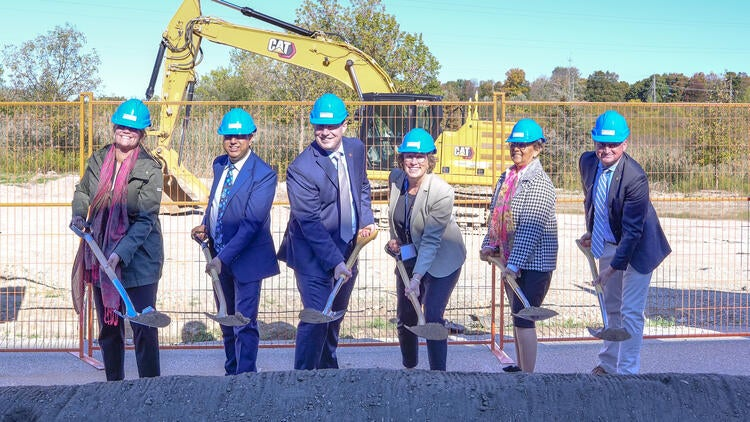The University of Waterloo has broken ground on WaterFEL, the Infrared Free Electron Laser (IR-FEL) facility scheduled to open in 2028. The new facility will be the only one of its kind in North America and will revolutionize research with its capabilities to address global challenges, from understanding and treating complex health conditions to creating pathways for a healthier environment.

From left to right: Nenone Donaldson, vice-president Advancement and External relations; Deepak Anand, MPP for Mississauga-Malton and Parliamentary Assistant to the Minister of Colleges, Universities, Research Excellence and Security; Dr. Scott Hopkins, professor, Department of Chemistry, Dorothy McCabe, mayor of Waterloo; Dr. Charmaine Dean, vice president Research and International and Dr. Chris Chris Houser, dean, Faculty of Science gather to celebrate the groundbreaking of the Infrared Free Electron Laser facility at the University of Waterloo.
The Canadian Free Electron Laser project received $10 million from the Canadian Foundation for Innovation (CFI), $6.4 million from the Ontario Research Fund (ORF), $3.6 million from the British Columbia Knowledge Development Fund, and $7.5 million from the University of Waterloo. The project consists of the IR-FEL at Waterloo and a complementary broad-based terahertz light source being built at TRIUMF, Canada's national particle accelerator laboratory in Vancouver.
The project, led by Dr. Scott Hopkins, was inspired by Nobel laureate and Waterloo professor Donna Strickland whose groundbreaking fundamental research in laser physics helped shape his vision for advancing laser technology. The IR-FEL will enable researchers to analyze the molecular structure of substances, monitor chemical transformations in wastewater and identify biomarkers for diseases such as cancer and metabolic diseases.
"The IR-FEL will offer an unprecedented level of detail in analyzing molecular and material structures," Hopkins explains. "The potential impact of the IR-FEL is enormous. It opens new possibilities for developing innovative treatments and improving personalized medicine."
WaterFEL will be adjacent to the new Waterloo hospital announced in 2024, which will create an environment for collaboration between research and health care professionals. This proximity will facilitate the rapid application of fundamental research findings to clinical practice. In 2025, Hopkins was awarded $250,000 from the Cancer Digital Intelligence's Grand Challenge to use AI combined with infrared laser technology to improve treatment options for brain and spine cancers.
Hopkins's research team aims to identify contaminants, including hazardous PFAS species known as "forever chemicals." Despite the sophisticated tools available, many molecules remain unidentified, which poses challenges to effective management or treatment.
"Our research aims to push the boundaries of detection and analysis," Hopkins says. "With FEL's advanced technologies, we will be able to identify and understand these puzzling molecules."
Waterloo's interdisciplinary expertise in physical sciences, engineering, computer science and artificial intelligence positions it as a leader in this groundbreaking research. WaterFEL will also play a vital role in training future scientists and equipping them with skills applicable across various fields.
At Waterloo, we envision a future where we have conquered the challenges of metabolic diseases and turned the tide on cancer treatments. A future where clean water and soil are free from pollutants and forever chemicals, and where scientists can follow their curiosity, connecting the chemistry of the universe to their experiments in the lab. Help us position Waterloo at the forefront of laser technology and scientific innovation.
For those inspired to help make the IR-FEL a reality, we invite you to connect with Meaghan Middleton, Director of Science Advancement, to learn how your generosity can transform innovation, collaboration and discovery.










